
William S. Hart, Robert Taylor
Fritz's Grave, Horseshoe Ranch, Newhall
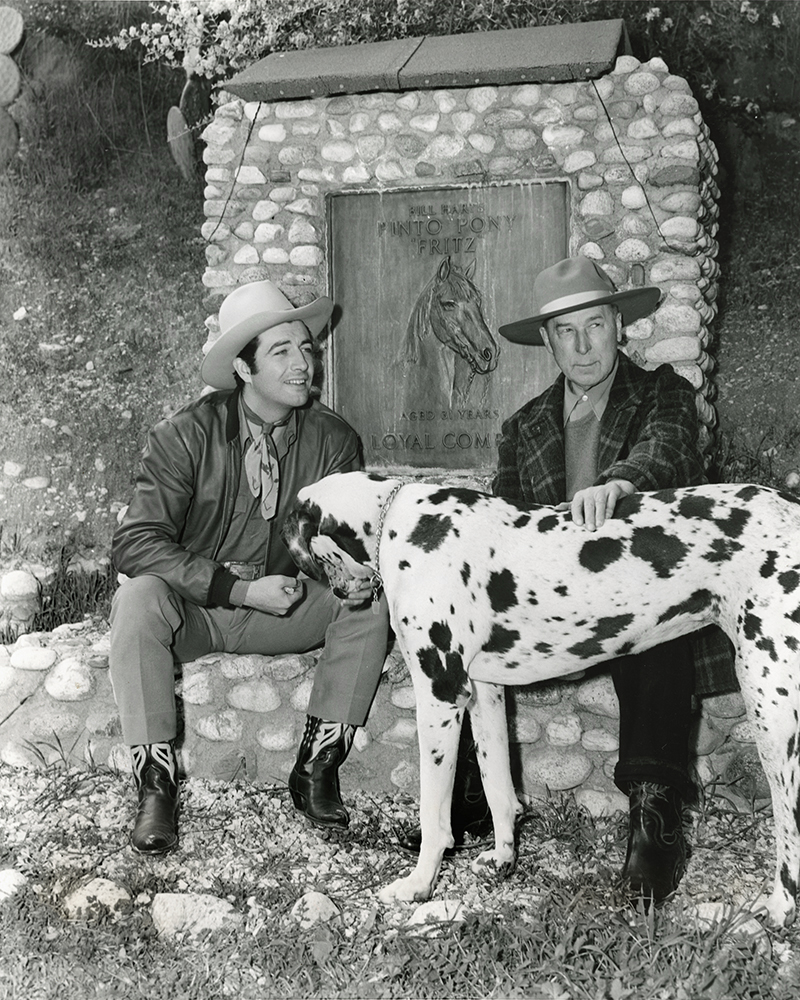
Click image to enlarge
| Download archival scan
|
ROBERT TAYLOR VISITS 1941
|

BTK Gun


Fritz's Grave

File Photo:
Hart-Fritz 1920s
|
Actor Robert Taylor, left, star of the upcoming MGM feature film, "Billy the Kid" (1941), poses for publicity photographs with a steely-eyed William S. Hart at the grave of Hart's famous horse, Fritz,
at Hart's Horseshoe Ranch in Newhall, where they're joined by one of Hart's twin harlequin Great Danes, either Gal or Prince (apparently Gal). Both dogs appear in at least one other photo made
at the same time and place.
8x10 glossy print distributed by Esquire Features, used to illustrate and unknown newspaper story in 1942. Cutline (below) reads:
The new star and the old star walk around the Hart ranch and stop by the grave of Bill Hart's famous pinto pony, Fritz. Long after he retired from pictures,
Fritz lived a life of ease on the Hart ranch. When he died he was 31 years old.
In an MGM publicity stunt, actor Robert Taylor and his then-wife Barbara Stanwyck spent the day at William S. Hart's Horseshoe Ranch in Newhall in February or March of 1941. The exact date is unclear; one account, published Sunday, March 23, says the visit took place "last weekend," while another says it fell on the third anniversary of the death of Hart's famous horse, Fritz. Fritz died February 6, 1938.
The purpose of the visit was reportedly to have Taylor pose for pictures with some of Hart's souvenirs, including a gun Hart believed to have been Billy the Kid's. Taylor was portraying Billy the Kid
in an upcoming MGM motion picture of that name and had been publicly looking for an authentic BTK gun to use on screen. Letters immediately poured in from 100 supposed
BTK gun owners. Somehow word got to Taylor that Hart had one, and the connection was made. Taylor was looking to buy, but Hart wasn't selling. Hart loaned the gun to Taylor and gave the young
Hollywood couple a Charles M. Russell painting to keep, instead, according to published reports (below).
In hindsight, an authentic Russell was no consolation prize. Hart's BTK gun was one of the many fakes, although neither man knew it. Sources disagree as to just when it was forged.
According to the Los Angeles Times (April 19, 1987), long after Hart's death the serial number was traced, and the gun was found to have been manufactured four months after the Kid was killed.
According to Joseph G. Rosa's "Age of the Gunfighter: Men and Weapons on the Frontier, 1840-1900" (University of Oklahoma Press, 1993), Hart's gun was made in 1887, six years after.
Even today, "newly discovered" BTK guns and photographs continue to surface.
A good many photographs were shot the day the actors met.
If Taylor used Hart's six-shooter in the movie, it must have been in some of the last scenes filmed, if their meeting was in March. "Billy the Kid" was in production at
the MGM studio in Culver City and on location in Arizona and Utah from December 13, 1940, to March 26, 1941, with pick-ups on April 15. The film premiered May 30, 1941.
Part of Hart's story of the gun is reported below: "An itinerant photographer who made the only portrait of the outlaw ... also offered his services as an engraver and etched a fancy 'Billy' into the metal strap of the butt" of the pistol.
Humorous note: "Hart complimented Taylor on his fine performance and then regarded Bob with a puzzled expression. 'Why do you do all your drawing and shooting with your left hand? The real Billy the Kid was a right-hander.'"
Studio experts showed Hart a copy of the only authentic photograph of the Kid, which appears to show him holding his rifle with his left hand. "Funny thing about that picture," Hart said. "I know the story well.
The photographer who made it mistakenly reversed the negative in his holder — and all the prints that came out of that batch made Billy look like a southpaw."
Unrelated — a significant passage about Hart's film rights appears below: "One thing Hart did that was pretty smart and brought him a lot of extra money was to stipulate in his contracts that the films he made become his at the end of ten years. He has negatives and prints of 22 of the 27 pictures he made. Hart Westerns still bring in some income. Bill is going to give the negatives and a print of each to the Museum of Modern Art in New York, whose film library is the most complete history of the movie business."
Finally, a note to would-be thieves: There are no handguns in the Hart Mansion or anywhere else at Hart Park today.
|
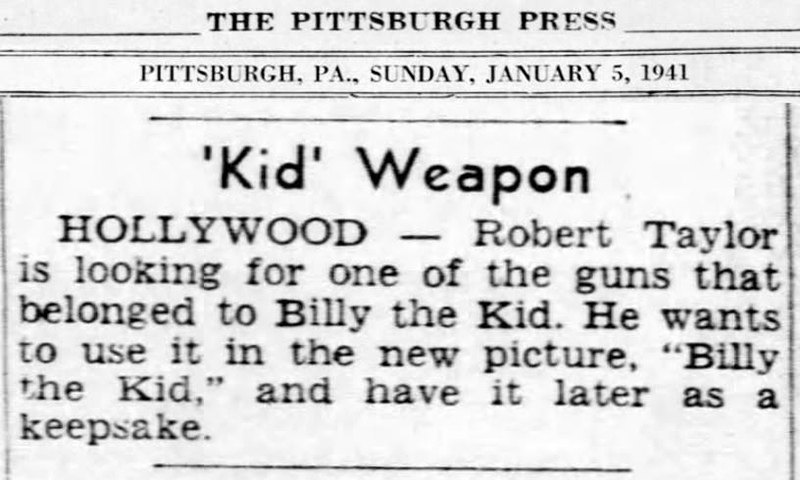
Click to enlarge.
|
The Pittsburgh Press | Sunday, January 5, 1941.
HOLLYWOOD — Robert Taylor is looking for one of the guns that belonged to Billy the Kid. He wants to use it in the new picture, "Billy the Kid," and have it later as a keepsake.
News story courtesy of Tricia Lemon Putnam.
|
|

Click to enlarge.
|
Chicago Daily Tribune | Friday, January 24, 1941.
Recently it was made known that Robert Taylor wanted Billy the Kid's own gun to use in
"Billy the K." To date he has received letters from 100 persons
claiming they have the gun.
News story courtesy of Tricia Lemon Putnam.
|
|
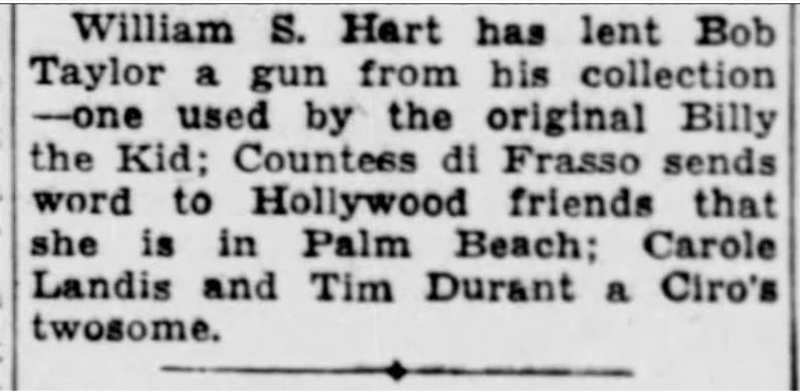
Click to enlarge.
|
Rochester (N.Y.) Democrat and Chronicle | March 17, 1941.
William S. Hart has lent Bob Taylor a gun from his collection — one used by the original Billy the Kid; Countess di Frasso sends word to Hollywood friends that she is in Palm Beach; Carole Landis and Tim Durant a Ciro's twosome.
News story courtesy of Tricia Lemon Putnam.
|
New York Daily News | Sunday, March 23, 1941.
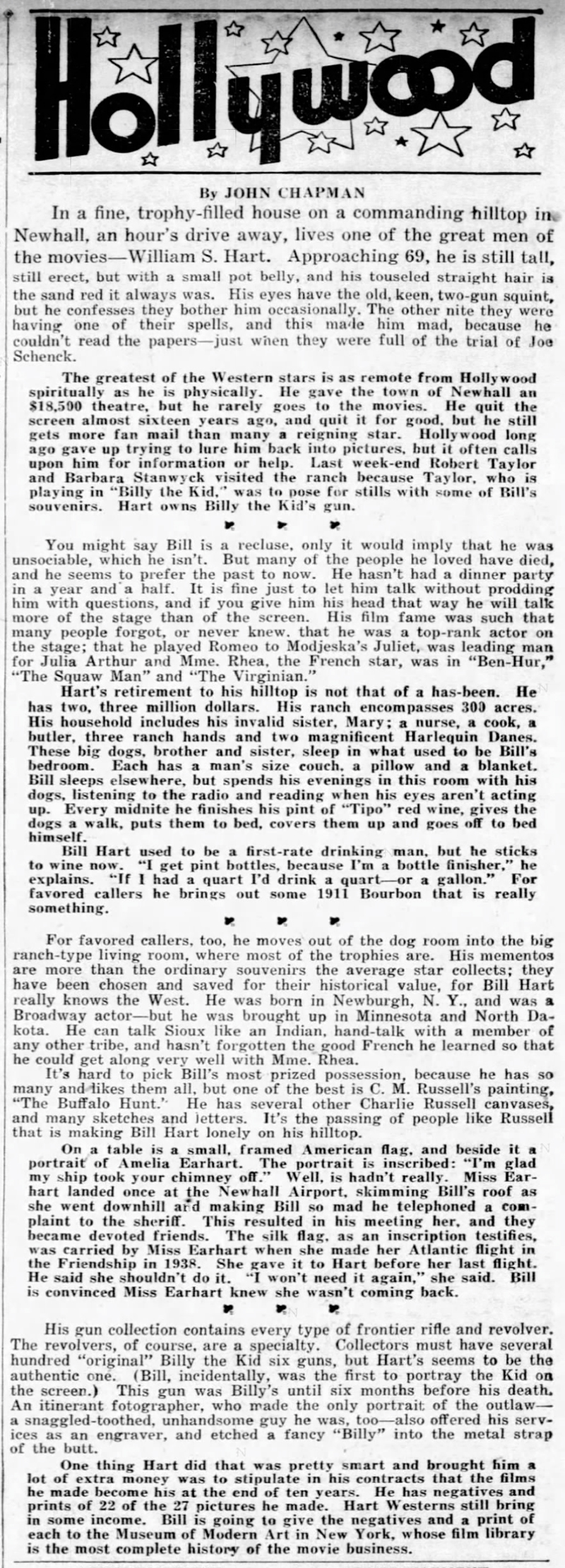
Click to enlarge.
|
In a fine, trophy-filled house on a commanding hilltop in Newhall, an hour's drive away, lives one of the great men of the movies — William S. Hart. Approaching 69 [sic: he was 76], he is still tall, still erect, but with a small pot belly, and his tousled straight hair is the sand red it always was. His eyes have the old, keen, two-gun squint, but he confesses they bother him occasionally. The other nite they were having one of their spells, and this made him mad, because he couldn't read the papers — just when they were full of the trial of Joe Schenck [Twentieth-Century Fox chairman who was convicted of tax evasion in 1941, sentenced in 1946 and subsequently pardoned by President Harry Truman.]
The greatest of the Western stars is as remote from Hollywood spiritually as he is physically. He gave the town of Newhall an $18,500 theatre, but he rarely goes to the movies. He quit the screen almost sixteen years ago, and quit it for good, but be still gets more fan mail than many a reigning star. Hollywood long ago gave up trying to lure him back into pictures [sic: other way around], but it often calls upon him for information or help. Last weekend Robert Taylor and Barbara Stanwyck visited the ranch because Taylor, who is playing in "Billy the Kid," was to pose for stills with some of Bill's souvenirs. Hart owns Billy the Kid's gun.
You might say Bill is a recluse, only it would imply that he was unsociable, which he isn't. But many of the people he loved have died, and he seems to prefer the past to now. He hasn't had a dinner party in a year and a half. It is fine just to let him talk without prodding him with questions, and if you give him his head that way he will talk more of the stage than of the screen. His film fame was such that many people forgot, or never knew, that he was a top-rank actor on the stage; that he played Romeo to Modjeska's Juliet, was leading man for Julia Arthur and Mme. Rhea, the French star, was in "Ben-Hur," "The Squaw Man" and "The Virginian."
Hart's retirement to his hilltop is not that of a has-been. He has two, three million dollars. His ranch encompasses 300 acres. His household includes his invalid sister, Mary; a nurse, a cook, a butler, three ranch hands and two magnificent Harlequin Danes. These big dogs, brother and sister, sleep in what used to be Bill's bedroom. Each has a man's size couch, a pillow and a blanket. Bill sleeps elsewhere but spends his evenings in this room with his dogs, listening to the radio and reading when his eyes aren't acting up. Every midnite he finishes his pint of "Tipo" red wine, gives the dogs a walk, puts them to bed. covers them up and goes off to bed himself.
Bill Hart used to be a first-rate drinking man, but he sticks to wine now. "I get pint bottles, because I'm a bottle finisher," he explains. "If I had a quart I'd drink a quart — or a gallon." For favored callers he brings out some 1911 Bourbon that is really something.
For favored callers, too, he moves out of the dog room into the big ranch-type living room, where most of the trophies are. His mementos are more than the ordinary souvenirs the average star collects; they have been chosen and saved for their historical value, for Bill Hart really knows the West. He was born in Newburgh, N.Y., and was a Broadway actor — but he was brought up in Minnesota and North Dakota. He can talk Sioux like an Indian, hand-talk with a member of any other tribe, and hasn't forgotten the good French he learned so that he could get along very well with Mme. Rhea.
It's hard to pick Bill's most prized possession, because he has so many and likes them all, but one of the best is C.M. Russell's painting, "The Buffalo Hunt." He has several other Charlie Russell canvases, and many sketches and letters. It's the passing of people like Russell that is making Bill Hart lonely on his hilltop.
On a table is a small, framed American flag, and beside it a portrait of Amelia Earhart. The portrait is inscribed: "I'm glad my ship took your chimney off." Well, is hadn't really. Miss Earhart landed once at the Newhall Airport, skimming Bill's roof as she went downhill and making Bill so mad he telephoned a complaint to the sheriff [sic: It wasn't Earhart; it was her partner, Paul Mantz.] This resulted in his meeting her, and they became devoted friends. The silk flag, as an inscription testifies, was carried by Miss Earhart when she made her Atlantic flight in the Friendship in 1938. She gave it to Hart before her last flight. He said she shouldn't do it. "I won't need it again," she said. Bill is convinced Miss Earhart knew she wasn't coming hack.
His gun collection contains every type of frontier rifle and revolver. The revolvers, of course, are a specialty. Collectors must have several hundred "original" Billy the Kid six guns, but Hart's seems to be the authentic one. (Bill, incidentally, was the first to portray the Kid on the screen.) This gun was Billy's until six months before his death. An itinerant photographer, who made the only portrait of the outlaw — a snaggled-toothed, unhandsome guy he was, too — also offered his services as an engraver, and etched a fancy "Billy" into the metal strap of the butt.
One thing Hart did that was pretty smart and brought him a lot of extra money was to stipulate in his contracts that the films he made become his at the end of ten years. He has negatives and prints of 22 of the 27 pictures he made. Hart Westerns still bring in some income. Bill is going to give the negatives and a print of each to the Museum of Modern Art in New York, whose film library is the most complete history of the movie business.
News story courtesy of Tricia Lemon Putnam.
|
|
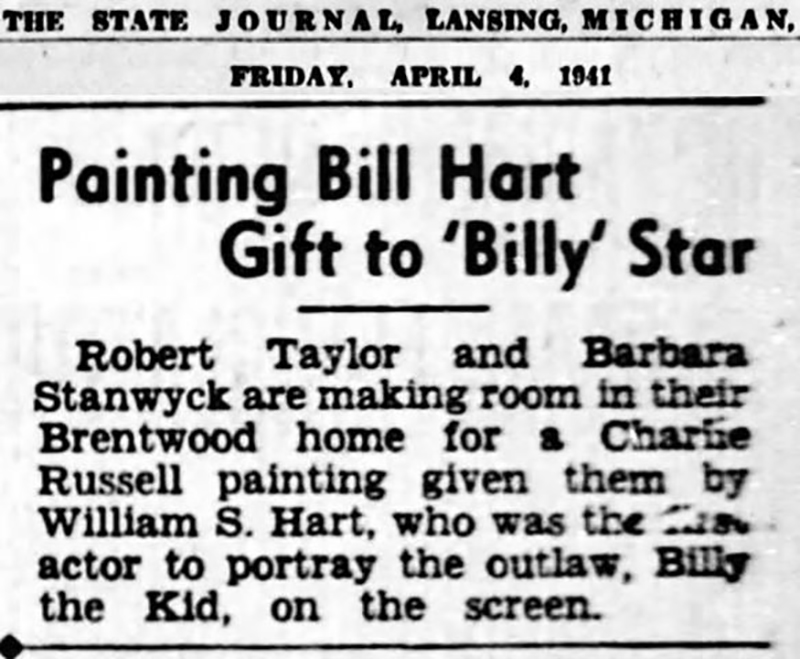
Click to enlarge.
|
Painting Bill Hart Gift to 'Billy' Star
(Lansing, Mich.) State Journal | Friday, April 4, 1941.
Robert Taylor and Barbara Stanwyck are making room in their Brentwood home for a Charlie Russell painting given them by William S. Hart, who was the first actor actor to portray the outlaw, Billy the Kid, on the screen.
News story courtesy of Tricia Lemon Putnam.
|
Research Men in Hollywood Have to Be On Toes.
Decatur (Ill.) Daily Review | April 14, 1941.

Click to enlarge.
|
Hollywood — Behind the scenes of movie production, Hollywood operates a giant "quiz" program all its own. And it always — most always, anyway — comes up with the right answers.
There are half a dozen intellectual fellows, one for each of the major studios, who are expected to know and deliver the correct answers to everything. It doesn't matter what the subject. These boys must be right. That's the basis on which they're paid off.
This select little group about whom so little is heard, except in case of glaring mistakes, are catalogued "technical directors."
However, not even a Hollywood research department can be 100 per cent right all the time, and this is to review a few of those embarrassing moments, big and little, that have bobbed up recently to confound the studios and particularly the men who are supposed to know everything there is to know.
Let's take the current case of Robert Taylor and "Billy the Kid." Before this remake based on the career of the notorious Oklahoma outlaw got before the cameras, Taylor was ordered to get out in his backyard every day for a month and convert himself into a left-handed gun-shooter.
For weeks, Taylor twiddled away with the pistol in his best Southpaw manner, which wasn't very good at first, but improved with time and diligent rehearsal. When the company was called together and the first scene shot, Taylor was mighty proud of his skill. He could yank out his gun, spin it menacingly with his forefinger and then straighten out and fire like all old Harry.
Taylor went right on with his left-handed killings and some mighty fine melodrama was piling up in the cans. Recalling that William S. Hart, leading outdoor hero of silent days, was a close student of Billy the Kid, studio officials decided to invite the veteran over for a look at the "rushes."
Hart complimented Taylor on his fine performance and then regarded Bob with a puzzled expression.
"But, why do you do all your drawing and shooting with your left hand? The real Billy the Kid was a right-hander. That's the way I always played him."
You can imagine the frantic scene that bit of comment touched off. Research was called into action immediately. The boys rushed down with the old print showing Billy standing there with a 30-30 in his left hand. They offered it to Hart with a "sez-you" smile.
"I've seen it before," chuckled the old-timer. "To my knowledge it's the only picture of Billy the Kid still in existence.
"Funny thing about that picture. I know the story well. The photographer who made it mistakenly reversed the negative in his holder — and all the prints that came out of that batch made Billy look like a southpaw."
News story courtesy of Tricia Lemon Putnam.
|
|
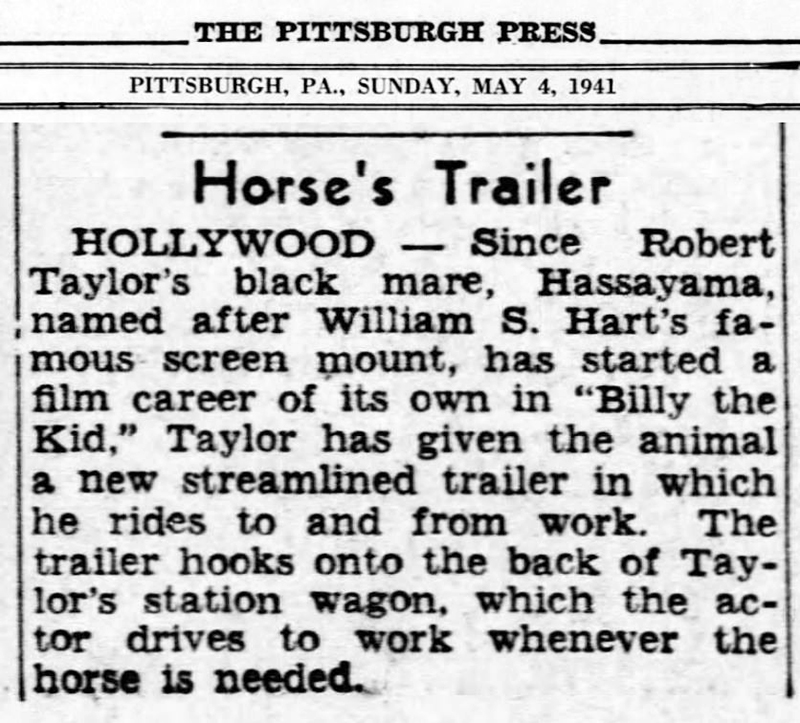
Click to enlarge.
|
The Pittsburgh Press | Sunday, May 4, 1941.
HOLLYWOOD — Since Robert Taylor's black mare, Hassayama, named after William S. Hart's famous screen mount*, has started a film career of its own in "Billy the Kid," Taylor has given the animal a new streamlined trailer in which he rides to and from work. The trailer hooks onto the back of Taylor's station wagon, which the actor drives to work whenever the horse is needed.
* Hart's horse was Hassayampa, which is a Yavapai word. See The Signal, July 5, 1934.
News story courtesy of Tricia Lemon Putnam.
|
|
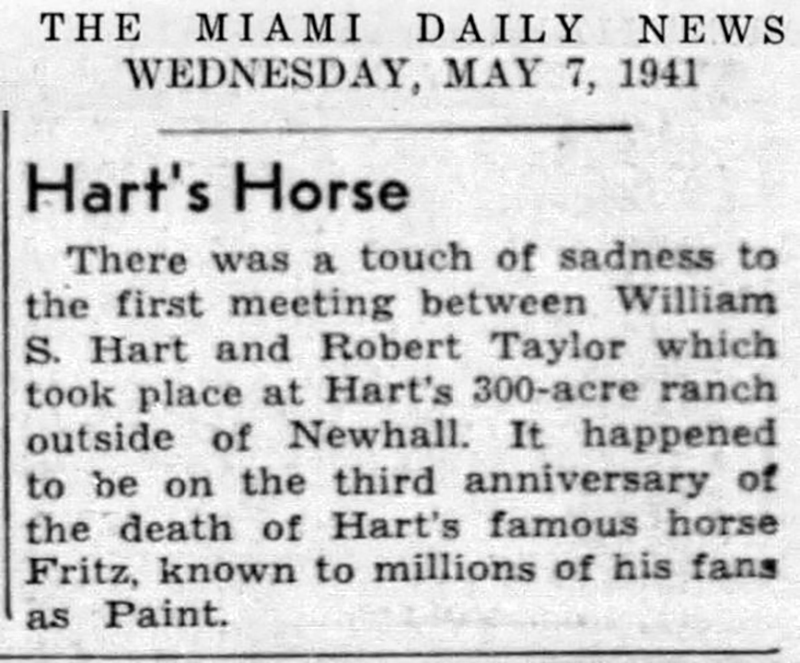
Click to enlarge.
|
Miami Daily News | Wednesday, May 7, 1941.
There was a touch of sadness to the first meeting between William S. Hart and Robert Taylor which took place at Hart's 300-acre ranch outside of Newhall. It happened to be on the third anniversary of the death of Hart's famous horse Fritz, known to millions of his fans as Paint.
News story courtesy of Tricia Lemon Putnam.
|
|
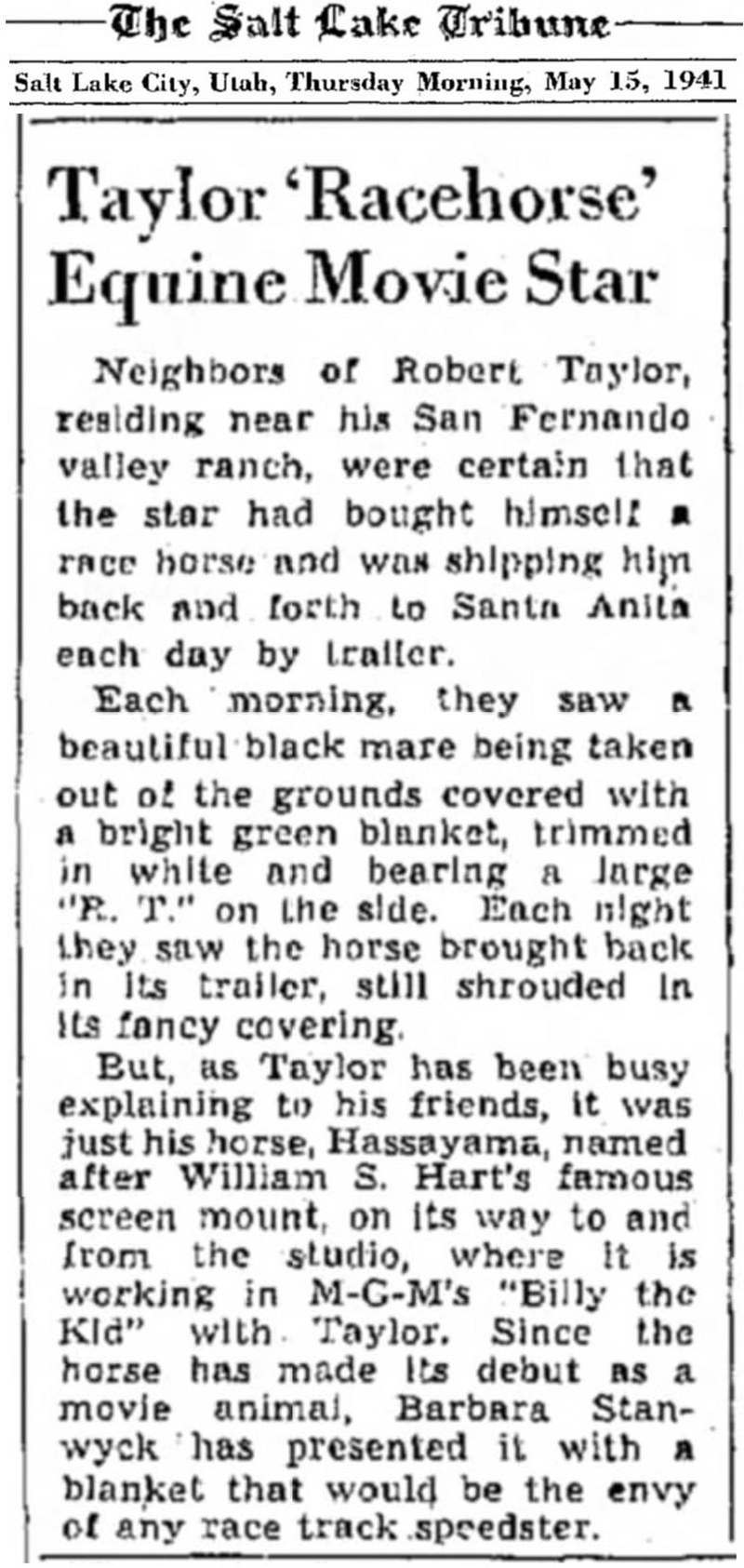
Click to enlarge.
|
Taylor 'Racehorse' Equine Movie Star
The Salt Lake Tribune | Thursday Morning, May 15, 1941.
Neighbors of Robert Taylor, residing near his San Fernando valley ranch, were certain that the star had bought himself a race horse and was shipping him back and forth to Santa Anita each day by trailer.
Each morning, they saw a beautiful black mare being taken out of the grounds covered with a bright green blanket, trimmed in white and bearing a large "R.T." on the side. Each night they saw the horse brought back in its trailer, still shrouded in its fancy covering.
But, as Taylor has been busy explaining to his friends, it was just his horse, Hassayama, named after William S. Hart's famous screen mount, on its way to and from the studio, where it is working in M-G-M's "Billy the Kid" with Taylor. Since the horse has made its debut as a movie animal, Barbara Stanwyck has presented it with a blanket that would be the envy of any race track speedster.
News story courtesy of Tricia Lemon Putnam.
|
|
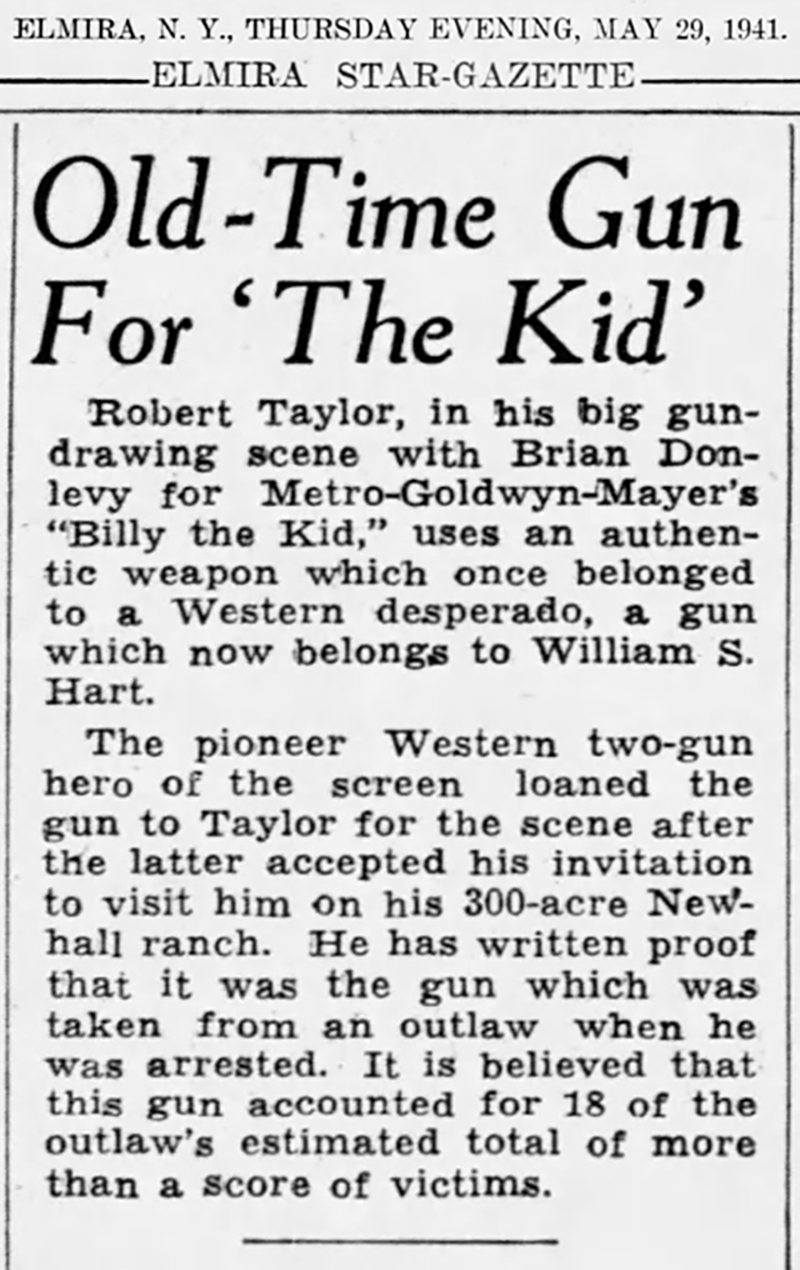
Click to enlarge.
|
Old-Time Gun for 'The Kid.'
Elmira (N.Y.) Star-Gazette | Thursday, May 29, 1941.
Robert Taylor, in his big gun-drawing scene with Brian Donlevy for Metro-Goldwyn-Mayer's "Billy the Kid," uses an authentic weapon which once belonged to a Western desperado, a gun which now belongs to William S. Hart.
The pioneer Western two-gun hero of the screen loaned the gun to Taylor for the scene after the latter accepted his invitation to visit him on his 300-acre Newhall ranch. He has written proof that it was the gun which was taken from an outlaw when he was arrested. It is believed that this gun accounted for 18 of the outlaw's estimated total of more than a score of victims.
News story courtesy of Tricia Lemon Putnam.
|
Taylor Realizes Boyhood Ambition — He's a Cowboy!
Brooklyn Daily Eagle | July 13, 1941.
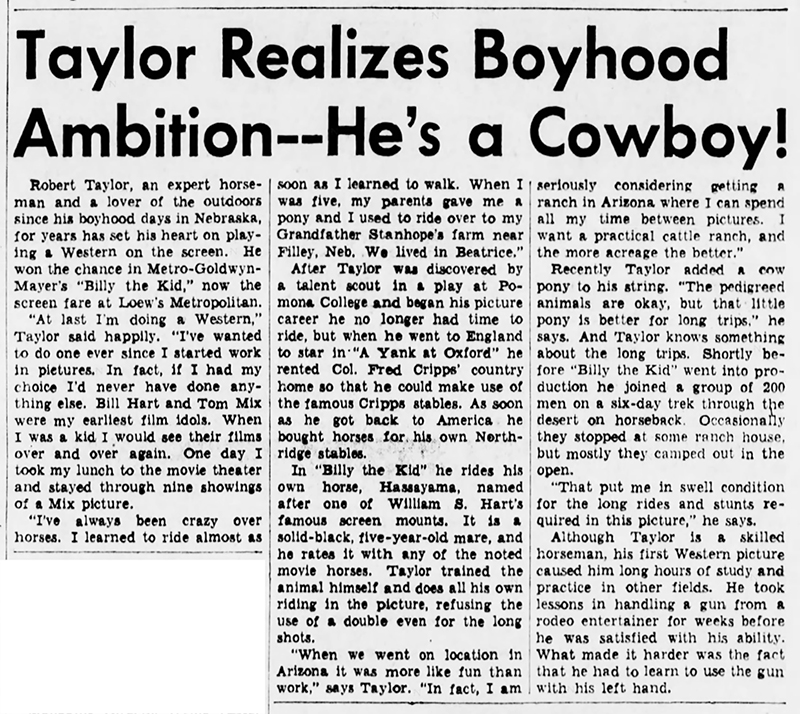
Click to enlarge.
|
Robert Taylor, an expert horseman and a lover of the outdoors since his boyhood days in Nebraska, for years has set his heart on playing a Western on the screen. He won the chance in Metro-Goldwyn-Mayer's "Billy the Kid," now the screen fare at Loew's Metropolitan.
"At last I'm doing a Western," Taylor said happily. "I've wanted to do one ever since I started work in pictures. In fact, If I had my choice I'd never have done anything else. Bill Hart and Tom Mix were my earliest film idols. When I was a kid I would see their films over and over again. One day I took my lunch to the movie theater and stayed through nine showings of a Mix picture.
"I've always been crazy over horses. I learned to ride almost as soon as I learned to walk. When I was five, my parents gave me a pony and I used to ride over to my Grandfather Stanhope's farm near Filley, Neb. We lived in Beatrice."
After Taylor was discovered by a talent scout in a play at Pomona College and began his picture career he no longer had time to ride, but when he went to England to star in "A Yank at Oxford" he rented Col. Fred Cripps' country home so that he could make use of the famous Cripps stables. As soon as he got back to America he bought horses for his own Northridge stables.
In "Billy the Kid" he rides his own horse, Hassayama, named after one of William S. Hart's famous screen mounts. It is a solid-black, five-year-old mare, and he rates it with any of the noted movie horses. Taylor trained the animal himself and does all his own riding in the picture, refusing the use of a double even for the long shots.
"When we went on location in Arizona it was more like fun than work," says Taylor. "In fact, I am seriously considering getting a ranch in Arizona where I can spend all my time between pictures. I want a practical cattle ranch, and the more acreage the better."
Recently Taylor added a cow pony to his string. "The pedigreed animals are okay, but that little pony is better for long trips," he says. And Taylor knows something about the long trips. Shortly before "Billy the Kid" went into production he joined a group of 200 men on a six-day trek through the desert on horseback. Occasionally, they stopped at some ranch house, but mostly they camped out in the open.
"That put me in swell condition for the long rides and stunts required in this picture," he says.
Although Taylor is a skilled horseman, his first Western picture caused him long hours of study and practice in other fields. He took lessons in handling a gun from a rodeo entertainer for weeks before he was satisfied with his ability. What made it harder was the fact that he had to learn to use the gun with his left hand.
News story courtesy of Tricia Lemon Putnam.
|
|
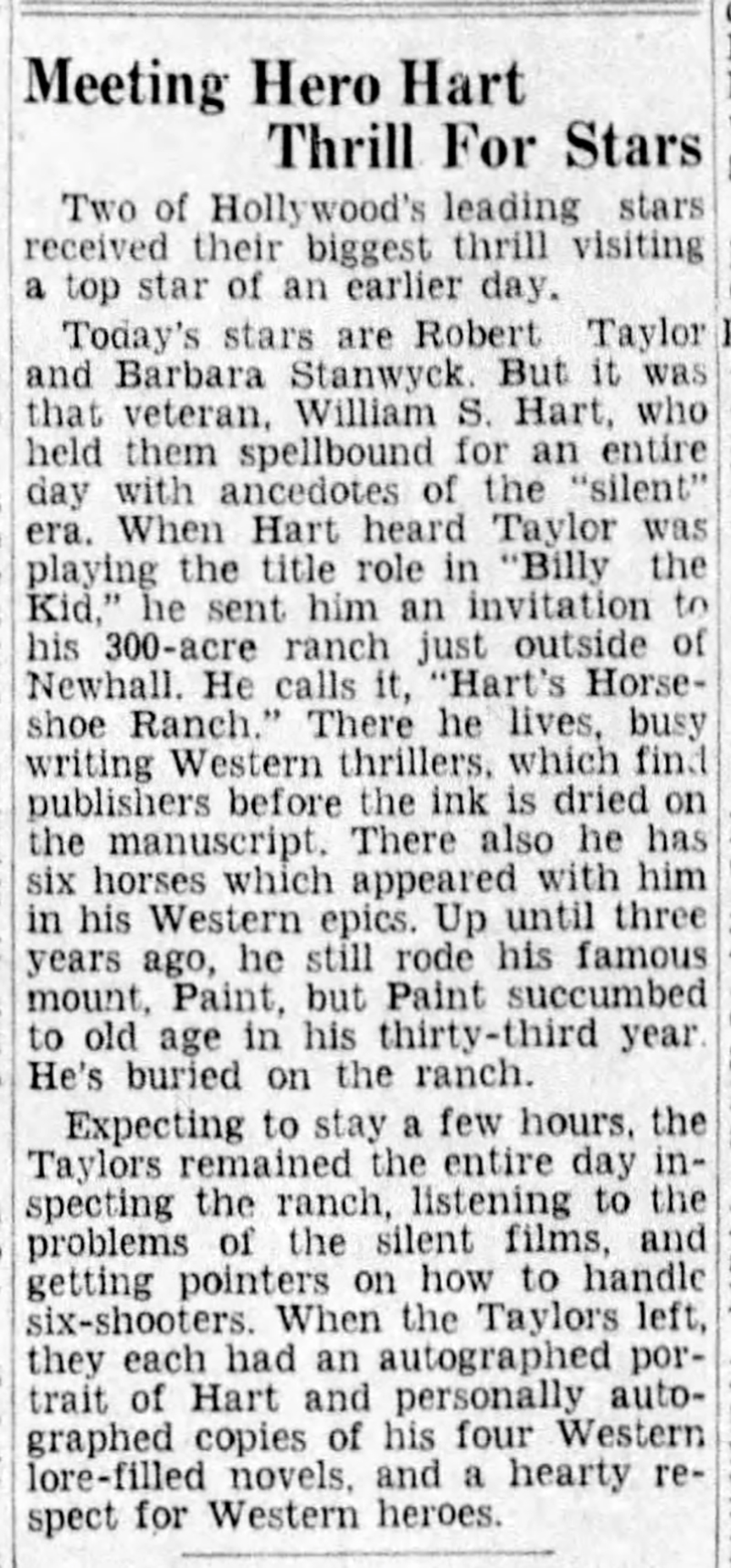
Click to enlarge.
|
Meeting Hero Hart Thrill For Stars
Hartford (Conn.) Daily Courant | July 27, 1941.
Two of Hollywood's leading stars received then biggest thrill visiting a top star of an earlier day.
Today's stars are Robert Taylor and Barbara Stanwyck. But it was that veteran, William S. Hart, who held them spellbound for an entire day with anecdotes of the "silent" era. When Hart heard Taylor was playing the title role in "Billy the Kid," he sent him an invitation to his 300-acre ranch just outside of Newhall. He calls it, "Hart's Horseshoe Ranch." There he lives, busy writing Western thrillers, which find publishers before the ink is dried on the manuscript. There also he has six horses which appeared with him in his Western epics. Up until three years ago, he still rode his famous mount, Paint, but Paint succumbed to old age in his thirty-third [sic: 31st] year. He's buried on the ranch.
Expecting to stay a few hours, the Taylors remained the entire day inspecting the ranch, listening to the problems of the silent films, and getting pointers on how to handle six-shooters. When the Taylors left, they each had an autographed portrait of Hart and personally autographed copies of his four Western lore-filled novels, and a hearty respect for Western heroes.
News story courtesy of Tricia Lemon Putnam.
|
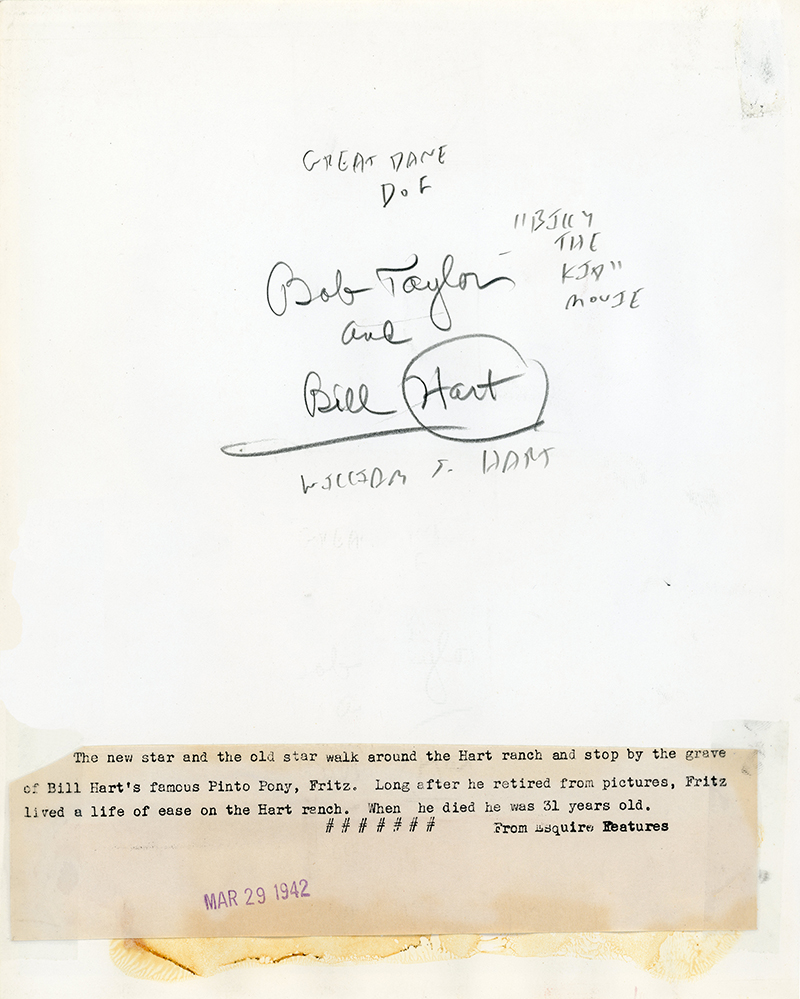
Click image to enlarge.
LW3433: 9600 dpi jpeg from original photograph purchased 2018 by Leon Worden.
|

Honored by Sioux 1926

Little Bighorn Anniversary 1926 x2

Dam Disaster 1928

With Charlie Mack in Newhall 1930s

With Wallace Beery, Moran & Mack in Newhall 1930s

With Lina Basquette 1932

Real Estate Instructions 1932

Watson Photo
1920s-1930s

At Saugus Rodeo 1933

Letter to M. Perkins 1933

With Freddie Bartholomew 1935

"Smiling" Bill Hart 1936

LA Times Feature 1936

Letter: Gift of Buffalo Coat to Rudy Vallee 1936

Letter: Gift of Buffalo Coat to Amelia Earhart 1936

Brown Derby 1938

Hart, Ione Reed, George Putnam 1938

With Andy Jauregui 1938

Guns on Radio 1941

Robert Taylor Photo Shoot 1941: BTK Gun, Fritz's Grave (Mult.)

With Dan White ~1945

With Horses 1940s

At Home 1-7-1946
|
|








































